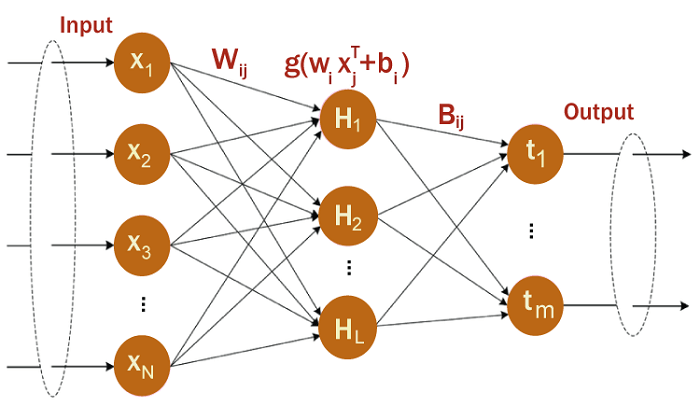ELM in Machine Learning
Huang et al. introduced the Extreme Learning Machine (ELM), a machine learning method in 2006. It is a type of feedforward artificial neural network that can learn from input data with high accuracy and efficiency. ELM has gained popularity in recent years due to its ability to solve a wide range of real-world problems in various fields, such as image and speech recognition, data classification, and regression analysis. Concept of ELMELM is a type of feedforward neural network that uses a single hidden layer with randomly generated weights and biases. Unlike other neural networks, ELM does not require iterative training or tuning of the weights and biases to achieve high accuracy. Instead, it uses an analytical solution to calculate the output weights based on the input data. The training phase and the testing phase are the two phases of the ELM algorithm hidden layer's weights, and biases are created at random when the input data is fed into the neural network during the training phase. The output weights are then calculated using a least-squares method. The training process is fast and does not require any iterative adjustment of the weights and biases. The input data is fed into the neural network during the testing phase, and the output is computed using the previously determined output weights. The output of the ELM algorithm is the same as that of other neural networks, which is a set of predicted values for each input. Architecture of ELM
The architecture of ELM consists of three layers: the input layer, the hidden layer, and the output layer. The input layer receives the input data, which is usually a set of feature vectors. The hidden layer contains a set of randomly generated weights and biases, and the output layer produces the predicted values. An essential element of the ELM is the buried layer's number of nodes. The complexity of the model and the precision of the predictions are influenced by the number of hidden nodes. In general, the more hidden nodes there are, the better the accuracy, but the more complex the model becomes. Finding the ideal quantity of hidden nodes for each issue is crucial. ELM TrainingTraining an ELM is a relatively simple and efficient process. The training data is first preprocessed, and the input and output values are normalized to a suitable range. The hidden layer size is then specified, and the random weights between the input and hidden layer are generated. The non-linear mapping is performed using a suitable activation function, such as the sigmoid or the hyperbolic tangent function. Once the hidden layer mapping is performed, the output weights are computed using a linear regression technique. Either the least squares approach or the Moore-Penrose pseudoinverse can be used to determine the output weights. The Moore-Penrose pseudoinverse is generally faster and more efficient than the least squares method, but it can be more prone to numerical instability. Once the output weights are computed, the output values can be computed using the output layer. Advantages of ELM
Limitations of ELM
Applications of ELMELM has been applied to a wide range of machine-learning problems, including classification, regression, and clustering. ELM has been used in image and speech recognition, financial forecasting, and medical diagnosis. ELM has also been used in natural language processing, recommendation systems, and bioinformatics. ConclusionIn conclusion, ELM is a powerful and efficient machine-learning algorithm that has gained widespread recognition in recent years. ELM is well-suited to handle a wide range of machine-learning problems, including classification, regression, and clustering. ELM has several advantages over other machine learning algorithms, including its speed, efficiency, and ability to handle high-dimensional and non-linear data. ELM has been applied to a wide range of real-life datasets.
Next TopicProbabilistic Model in Machine Learning
|
 For Videos Join Our Youtube Channel: Join Now
For Videos Join Our Youtube Channel: Join Now
Feedback
- Send your Feedback to [email protected]
Help Others, Please Share










